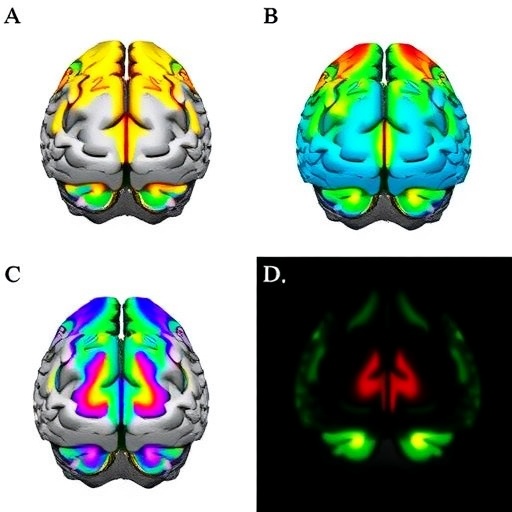In groundbreaking new research that delves deep into the complex relationship between brain function and adolescent psychopathology, scientists have now unveiled sex-specific neural signatures linked to behavioral disorders in teenagers. This study, recently published in Translational Psychiatry, leverages advanced data science techniques to dissect the intricate interplay of brain-behavior associations, highlighting not only the biological underpinnings of mental health but also their divergent expressions across males and females during this critical developmental period.
Adolescence has long been recognized as a vulnerable window for the onset of various psychiatric disorders, yet understanding the precise neurological correlates that map onto these emerging pathologies remains an ongoing challenge. The researchers have utilized a sophisticated analytical approach known as Regularized Canonical Correlation Analysis (rCCA), which enhances the capability to detect meaningful correspondences between multidimensional brain imaging data and behavioral symptomatology. This methodological innovation allows for more precise modeling of the brain-behavior axis with an unprecedented resolution.
Regularized CCA operates by statistically linking two sets of high-dimensional data — in this case, comprehensive neuroimaging metrics and detailed clinical behavioral assessments — to uncover latent variables that explain shared variance across these complex datasets. Unlike traditional methods, the regularization component mitigates overfitting problems often encountered when dealing with highly correlated features, thus yielding robust, generalizable findings. The incorporation of this technique represents a significant leap forward in computational neuropsychiatry.
By applying rCCA in a large cohort of adolescents exhibiting psychopathological symptoms, the researchers identified distinct neural-behavioral association patterns that differ markedly by biological sex. These findings underscore the necessity of sex-specific frameworks in understanding brain function alterations linked to mental health disorders during adolescence. Historically, many neuropsychiatric studies have neglected sex differences, potentially obscuring critical nuances that could inform tailored interventions.
The study’s results reveal that male and female adolescents exhibit unique brain network signatures correlated with specific behavioral domains such as anxiety, depression, and impulsivity. For males, alterations in particular brain regions involved in emotional regulation and cognitive control were closely tied to clinical symptoms, whereas for females, distinct neural pathways associated with social cognition and reward processing showed stronger associations. This divergence provides compelling evidence for underlying neurobiological mechanisms shaped by sex, which influence how psychopathology manifests during adolescence.
Furthermore, the integration of behavioral phenotyping with neuroimaging enables a multidimensional characterization of psychiatric symptoms, moving beyond traditional categorical diagnoses toward a more nuanced dimensional understanding. This approach aligns with recent calls in psychiatry for precision medicine based on individual neurobiological profiles, offering potential pathways to develop personalized therapeutics that are sensitive to sex differences.
The research also highlights the utility of combining advanced statistical tools with large-scale brain imaging data to unravel complex brain-behavior relationships that were previously difficult to discern. As adolescent mental health continues to present a major public health challenge worldwide, such studies are instrumental in bridging the gap between neurobiology and clinical symptomatology. They pave the way for new diagnostic classifications grounded in brain function rather than solely symptom-based criteria.
Importantly, the sex-specific findings have significant implications for both basic neuroscience and clinical practice. They suggest that interventions targeting adolescent psychopathology may benefit from tailoring strategies based on biological sex, potentially enhancing treatment efficacy and outcome prediction. This concept dovetails with emerging trends advocating for gender- and sex-informed approaches across medical disciplines.
Moreover, the study enhances our fundamental understanding of adolescent brain development by illuminating how divergent brain networks underpin behaviorally relevant symptoms in males and females. These insights contribute to a growing body of literature emphasizing developmental trajectories that differ between sexes, shaping vulnerability and resilience to psychiatric conditions during this formative period.
The authors acknowledge some limitations, including the observational nature of the study and the need for longitudinal validation to establish causal relationships. Nevertheless, the technical rigor and innovative analytic framework provide a solid foundation for further research exploring mechanistic pathways and potential biomarkers of adolescent psychopathology.
Looking ahead, future investigations could expand upon this work by incorporating genetic, hormonal, and environmental modulators to create even richer models of brain-behavior dynamics. Such integrative studies hold promise for elucidating the multifactorial causes of mental illness and refining individualized interventions that consider both neurodevelopmental timing and sex-specific influences.
In conclusion, this pioneering application of Regularized Canonical Correlation Analysis in adolescent psychiatry marks a significant advance in decoding the sex-specific neural correlates of varied psychopathological symptoms. The findings advocate for more gender-sensitive paradigms in mental health research and care, underscoring the importance of nuanced neurobiological mapping to address the unique vulnerabilities and therapeutic needs of male and female adolescents.
As the global community grapples with rising rates of mental health disorders among youths, the insights gained from this study offer hope for more precise diagnostic tools and treatment frameworks. Through continued integration of cutting-edge computational techniques with neurobiological inquiry, the path towards personalized psychiatry becomes ever clearer.
These revelations not only deepen scientific understanding but also carry the potential to transform clinical approaches, providing a roadmap for targeted therapies that honor the biological and psychological complexity of adolescent mental health. This work exemplifies the power of interdisciplinary innovation in forging new frontiers in neuroscience and psychiatry.
The convergence of neuroimaging, advanced analytics, and clinical psychology heralds an exciting era where mental health treatment is informed by individualized brain mechanisms rather than one-size-fits-all models. This paradigm shift will be critical to effectively addressing the nuanced challenges presented by adolescent psychopathology across sexes, enabling improved care and outcomes for future generations.
Subject of Research: The study investigates sex-specific brain-behavior associations in adolescent psychopathology using advanced neuroimaging and computational methods.
Article Title: Regularized CCA identifies sex-specific brain-behavior associations in adolescent psychopathology
Article References:
Milecki, L., Gonzalez, C., Adeli, E. et al. Regularized CCA identifies sex-specific brain-behavior associations in adolescent psychopathology. Transl Psychiatry 15, 405 (2025). https://doi.org/10.1038/s41398-025-03678-9
Image Credits: AI Generated
DOI: https://doi.org/10.1038/s41398-025-03678-9




